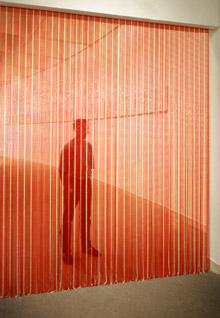
Untitled (Blood) Felix Gonzalez-Torres's 57-foot-wide curtain of fabulous, shimmering red plastic beads serves as a metaphor for the AIDS epidemic. |
"Flesh was the reason oil paint was invented," Willem de Kooning argued in the 1950s. This sensual awareness set his paintings apart —attuned to the seductive physicality of paint as well as the lusciousness of color — and surely was part of his luck with the ladies. But after the '60s, such tactile, corporeal oomph became rare in art as Minimalism, Conceptualism, Post-Modernism, and so on favored the cerebral and black and white instead (see: the Institute of Contemporary Art's recent "Dance/Draw").
>> SLIDESHOW: "Figuring Color" at the ICA <<
ICA curator Jenelle Porter's exhibit "Figuring Color" (through May 20) proposes that sexy, fleshy color has returned. She uses half the museum's top floor to round up four artists spanning two decades to explore "the connection between color and the body." Here bodies become fleshy pots, beads, furniture, and cartoon guts.
If visceral color is back, Felix Gonzalez-Torres, a New Yorker who died of AIDS in 1996, was one of the artists who led the way. (Though it's worth noting that Gary Panther, Robert Williams, and other painters and craftspeople in the Lowbrow crowd were creating work that was flush with skin and color the whole time.) During the '80s and '90s, Kiki Smith sculpted battered figures trailing beads like blood or urine, and Andres Serrano photographed blood and milk and, infamously, a crucifix submerged in urine. Martyrs and bodily fluids spoke of the devastation of AIDS.
Meanwhile, Gonzalez-Torres produced combative posters and timelines about AIDS with the activist collective Group Material. But his personal work was more romantic, charming and, at first glance, innocuous. Here his 1992 Untitled (Blood) turns the ascetic, minimalist tropes of repetition and manufactured materials into a 57-foot-wide curtain of fabulous, shimmering red plastic beads. The mists of two decades' time now fog his concept: a waterfall of blood that we touch and pass through, the stuff of life, but fatally contagious.
The show then leaps forward a decade. Man y of Seattle and San Diego artist Roy McMakin's works here are single pieces of jokey studio furniture, like his easy chair with a fat ass. But Lequita Faye Melvin (2003) clusters (mainly) bedroom furniture — two bed frames, a clock, a couple of soft chairs, four lamps, a pile of cushions, a couple of bureaus — together in the center of a gallery. The designs, which he had built by workers in his studio, are based on memories of his parents' and grandparents' homes. (The title is his mom's maiden name.) In a departure from the show's bright palette, everything's painted the same flat gray. The color plus the grouping suggests the owner is gone (dead? evicted?) and the furniture is assembled for moving or sale, a temporary monument to loss.
New Yorker Sue Williams's paintings, like Record Profits (2008), are giddily grim jokes on midcentury Abstract Expressionism, in which a red-and-white, Pollock-like composition of dashingly calligraphic cartooning turns out, on closer inspection, to be exploding eyeballs, brains, blood vessels, viscera. Williams cites the War on Terror as inspiration, but the point is the paint, and the deliciously tasteless Zap Comix fun.